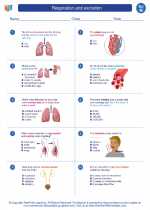Combined Gas Law
The combined gas law is a gas law that combines Charles's law, Boyle's law, and Gay-Lussac's law. It relates the volume, pressure, and temperature of a gas. The combined gas law is expressed by the formula:
P1V1 / T1 = P2V2 / T2
Where:
- P1 = initial pressure of the gas
- V1 = initial volume of the gas
- T1 = initial temperature of the gas (in Kelvin)
- P2 = final pressure of the gas
- V2 = final volume of the gas
- T2 = final temperature of the gas (in Kelvin)
Study Guide
Here are some key points to remember when studying the combined gas law:
- Units: Always make sure that the temperature is in Kelvin (K) when using the combined gas law.
- Proportional Relationships: Understand the direct and inverse relationships between pressure, volume, and temperature in the combined gas law.
- Manipulating the Formula: Practice rearranging the formula to solve for different variables (e.g., solving for final volume or final pressure).
- Real-world Applications: Explore real-world examples where the combined gas law can be applied, such as in scuba diving or in the operation of internal combustion engines.
By understanding the combined gas law and its applications, you can gain a deeper insight into the behavior of gases under different conditions.
.◂Science Worksheets and Study Guides Eighth Grade. Respiration and excretion
Study Guide Respiration and excretion
Respiration and excretion  Worksheet/Answer key
Worksheet/Answer key Respiration and excretion
Respiration and excretion  Worksheet/Answer key
Worksheet/Answer key Respiration and excretion
Respiration and excretion  Worksheet/Answer key
Worksheet/Answer key Respiration and excretion
Respiration and excretion  Vocabulary/Answer key
Vocabulary/Answer key Respiration and excretion
Respiration and excretion  Vocabulary/Answer key
Vocabulary/Answer key Respiration and excretion
Respiration and excretion  Vocabulary/Answer key
Vocabulary/Answer key Respiration and excretion
Respiration and excretion  Vocabulary/Answer key
Vocabulary/Answer key Respiration and excretion
Respiration and excretion 

 Worksheet/Answer key
Worksheet/Answer key
 Worksheet/Answer key
Worksheet/Answer key
 Worksheet/Answer key
Worksheet/Answer key
 Vocabulary/Answer key
Vocabulary/Answer key
 Vocabulary/Answer key
Vocabulary/Answer key
 Vocabulary/Answer key
Vocabulary/Answer key
 Vocabulary/Answer key
Vocabulary/Answer key
